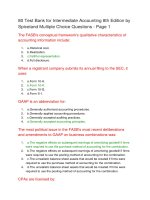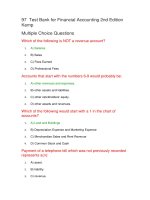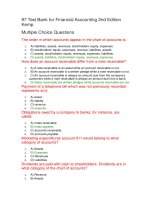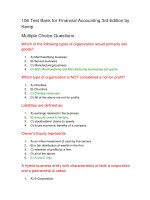Test bank for financial accounting 8th edition part 1 by weygandt
Bạn đang xem bản rút gọn của tài liệu. Xem và tải ngay bản đầy đủ của tài liệu tại đây (225.25 KB, 36 trang )
Test Bank for Financial Accounting 8th Edition Part 1 by
Weygandt
Accountants refer to an economic event as a
1. a. purchase.
2. b. sale.
3. c. transaction.
4. d. change in ownership.
The process of recording transactions has become more efficient because
1. a. fewer events can be quantified in financial terms.
2. b. computers are used in processing business events.
3. c. more people have been hired to record business transactions.
4. d. business events are recorded only at the end of the year.
Communication of economic events is the part of the accounting process that
involves
1. a. identifying economic events.
2. b. quantifying transactions into dollars and cents.
3. c. preparing accounting reports.
4. d. recording and classifying information.
Which of the following events cannot be quantified into dollars and cents and
recorded as an accounting transaction?
1. a. The appointment of a new CPA firm to perform an audit.
2. b. The purchase of a new computer.
3. c. The sale of store equipment.
4. d. Payment of income taxes.
The use of computers in recording business events
1. a. has made the recording process more efficient.
2. b. does not use the same principles as manual accounting systems.
3. c. has greatly impacted the identification stage of the accounting process.
4. d. is economical only for large businesses.
The accounting process involves all of the following except
1. a. identifying economic transactions that are relevant to the business.
2. b. communicating financial information to users by preparing financial
reports.
3. c. recording nonquantifiable economic events.
4. d. analyzing and interpreting financial reports.
The accounting process is correctly sequenced as
1. a. identification, communication, recording.
2. b. recording, communication, identification.
3. c. identification, recording, communication.
4. d. communication, recording, identification.
Which of the following techniques are not used by accountants to interpret
and report financial information?
1. a. Graphs.
2. b. Special memos for each class of external users.
3. c. Charts.
4. d. Ratios.
Accounting consists of three basic activities which are related to economic
events of an organization. These include
1. a. identifying, recording, and communicating
2. b. identifying, calculating, and responding
3. c. classifying, numbering, and reporting
4. d. issuing, reporting, and classifying
All of the following statements are correct except
1. a. Good decision-making depends on good information.
2. b. A vital element in communicating economic events is the accountant's
ability to analyze and interpret reported information.
3. c. The origins of accounting are generally attributed to Socrates, a classical
Greek philosopher, who promoted accounting as a social contract.
4. d. The information that a user of financial information needs depends upon
the kinds of decisions the user makes.
Which of the following would not be considered an internal user of accounting
data for the GHI Company?
1. a. President of the company.
2. b. Production manager.
3. c. Merchandise inventory clerk.
4. d. President of the employees' labor union.
Which of the following would not be considered an external user of
accounting data for the GHI Company?
1. a. Internal Revenue Service Agent.
2. b. Management.
3. c. Creditors.
4. d. Customers.
Which of the following would not be considered internal users of accounting
data for a company?
1. a. The president of a company.
2. b. The controller of a company.
3. c. Creditors of a company.
4. d. Salesmen of the company.
Which of the following is an external user of accounting information?
1. a. Labor unions.
2. b. Finance directors.
3. c. Company officers.
4. d. Managers.
Which one of the following is not an external user of accounting
information?
1. a. Regulatory agencies.
2. b. Customers.
3. c. Investors.
4. d. All of these are external users.
Bookkeeping differs from accounting in that bookkeeping primarily involves
which part of the accounting process?
1. a. Identification.
2. b. Communication.
3. c. Recording.
4. d. Analysis.
The origins of accounting are generally attributed to the work of
1. a. Christopher Columbus.
2. b. Abner Doubleday.
3. c. Luca Pacioli.
4. d. Leonardo da Vinci.
Financial accounting provides economic and financial information for all of
the following except
1. a. creditors.
2. b. investors.
3. c. managers.
4. d. other external users.
The final step in solving an ethical dilemma is to
1. a. identify and analyze the principal elements in the situation.
2. b. recognize an ethical situation.
3. c. identify the alternatives and weigh the impact of each alternative on
stakeholders.
4. d. recognize the ethical issues involved.
The first step in solving an ethical dilemma is to
1. a. identify and analyze the principal elements in the situation.
2. b. identify the alternatives.
3. c. recognize an ethical situation and the ethical issues involved.
4. d. weigh the impact of each alternative on various stakeholders.
Ethics are the standards of conduct by which one's actions are judged as
1. a. right or wrong.
2. b. honest or dishonest.
3. c. fair or unfair.
4. d. all of these.
All of the following are steps in analyzing ethics cases in financial reporting
except
1. a. identify and analyze the principle elements in the situation.
2. b. contact law enforcement regarding any violations of corporate ethics codes
3. c. identify the alternatives and weigh the impact of each alternative on
various stakeholders.
4. d. recognize an ethical situation and the ethical issues involved.
In order to increase comparability, in recent years, the FASB and IASB have
made efforts to reduce the differences between U.S.GAAP and IFRS through a
process known as
1. a. convergence
2. b. monetary unit assumption
3. c. the cost principle
4. d. the fair value principle
Martin Corporation purchased land in 2007 for $290,000. In 2013, it
purchased a nearly identical parcel of land for $460,000. In its 2013 balance
sheet, Martin valued these two parcels of land at a combined value of
$920,000. By reporting the land in this manner, Martin Corp. has violated
the
1. a. cost principle
2. b. convergence
3. c. economic entity assumption
4. d. monetary unit assumption
Andre Dickinson, owner of Andre's Fine Wines, also owns a personal residence
that costs $475,000. The market value of his residence is $625,000. During
preparation of the financial statements for Andre's Fine Wines, the
accounting concept most relevant to the presentation of Andre's home is
1. a. the economic entity assumption.
2. b. the fair value principle.
3. c. the monetary unit assumption.
4. d. convergence.
Generally accepted accounting principles are
1. a. income tax regulations of the Internal Revenue Service.
2. b. standards that indicate how to report economic events.
3. c. theories that are based on physical laws of the universe.
4. d. principles that have been proven correct by academic researchers.
The cost principle requires that when assets are acquired, they be recorded
at
1. a. appraisal value.
2. b. cost.
3. c. market price.
4. d. book value.
The cost of an asset and its fair value are
1. a. never the same.
2. b. the same when the asset is sold.
3. c. irrelevant when the asset is used by the business in its operations.
4. d. the same on the date of acquisition.
The body of theory underlying accounting is not based on
1. a. physical laws of nature.
2. b. concepts.
3. c. principles.
4. d. definitions.
The private sector organization involved in developing accounting principles
is the
1. a. Feasible Accounting Standards Body.
2. b. Financial Accounting Studies Board.
3. c. Financial Accounting Standards Board.
4. d. Financial Auditors' Standards Body.
The SEC and FASB are two organizations that are primarily responsible for
establishing generally accepted accounting principles. It is true that
1. a. they are both governmental agencies.
2. b. the SEC is a private organization of accountants.
3. c. the SEC often mandates guidelines when no accounting principles exist.
4. d. the SEC and FASB rarely cooperate in developing accounting standards.
GAAP stands for
1. a. Generally Accepted Auditing Procedures.
2. b. Generally Accepted Accounting Principles.
3. c. Generally Accepted Auditing Principles.
4. d. Generally Accepted Accounting Procedures.
Financial information that is capable of making a difference in a decision
is
1. a. faithfully representative.
2. b. relevant.
3. c. convergent.
4. d. generally accepted.
The Duce Company has five plants nationwide that cost a total of $100
million. The current fair value of the plants is $500 million. The plants will be
recorded and reported as assets at
1. a. $100 million.
2. b. $600 million.
3. c. $400 million.
4. d. $500 million.
The fair value principle is applied for
1. a. all assets.
2. b. current assets.
3. c. buildings.
4. d. investment securities.
The proprietorship form of business organization
1. a. must have at least three owners in most states.
2. b. represents the largest number of businesses in the United States.
3. c. combines the records of the business with the personal records of the
owner.
4. d. is characterized by a legal distinction between the business as an
economic unit and the owner.
The economic entity assumption requires that the activities
1. a. of different entities can be combined if all the entities are corporations.
2. b. must be reported to the Securities and Exchange Commission.
3. c. of a sole proprietorship cannot be distinguished from the personal
economic events of its owners.
4. d. of an entity be kept separate from the activities of its owner.
A business organized as a corporation
1. a. is not a separate legal entity in most states.
2. b. requires that stockholders be personally liable for the debts of the
business.
3. c. is owned by its stockholders.
4. d. terminates when one of its original stockholders dies.
The partnership form of business organization
1. a. is a separate legal entity.
2. b. is a common form of organization for service-type businesses.
3. c. enjoys an unlimited life.
4. d. has limited liability.
Which of the following is not an advantage of the corporate form of business
organization?
1. a. Limited liability of stockholders
2. b. Transferability of ownership
3. c. Unlimited personal liability for stockholders
4. d. Unlimited life
A small neighborhood barber shop that is operated by its owner would likely
be organized as a
1. a. joint venture.
2. b. partnership.
3. c. corporation.
4. d. proprietorship.
John and Sam met at law school and decide to start a small law practice after
graduation. They agree to split revenues and expenses evenly. The most
common form of business organization for a business such as this would be
a
1. a. joint venture.
2. b. partnership.
3. c. corporation.
4. d. proprietorship.
Which of the following is true regarding the corporate form of business
organization?
1. a. Corporations are the most prevalent form of business organization.
2. b. Corporate businesses are generally smaller in size than partnerships and
proprietor-ships.
3. c. The revenues of corporations are greater than the combined revenues of
partnerships and proprietorships.
4. d. Corporations are separate legal entities organized exclusively under
federal law.
A basic assumption of accounting that requires activities of an entity be kept
separate from the activities of its owner is referred to as the
1. a. stand alone concept.
2. b. monetary unit assumption.
3. c. corporate form of ownership.
4. d. economic entity assumption.
Ted Leo is the proprietor (owner) of Ted's, a retailer of golf apparel. When
recording the financial transactions of Ted's, Ted does not record an entry for
a car he purchased for personal use. Ted took out a personal loan to pay for
the car. What accounting concept guides Ted's behavior in this situation?
1. a. Pay back concept
2. b. Economic entity assumption
3. c. Cash basis concept
4. d. Monetary unit assumption
A basic assumption of accounting assumes that the dollar is
1. a. unrelated to business transactions.
2. b. a poor measure of economic activities.
3. c. the common unit of measure for all business transactions.
4. d. useless in measuring an economic event.
Mofro’s Computer Repair Shop started the year with total assets of $270,000
and total liabilities of $180,000. During the year, the business recorded
$450,000 in computer repair revenues, $270,000 in expenses, and Mofro paid
dividends of $45,000. Stockholders' equity at the end of the year was
1. a. $180,000.
2. b. $210,000.
3. c. $225,000.
4. d. $270,000.
Mofro’s Computer Repair Shop started the year with total assets of $270,000
and total liabilities of $180,000. During the year, the business recorded
$450,000 in computer repair revenues, $270,000 in expenses, and Mofro paid
dividends of $45,000. The net income reported by Mofro's Computer Repair
Shop for the year was
1. a. $90,000.
2. b. $135,000.
3. c. $180,000.
4. d. $225,000.
Mofro’s Computer Repair Shop started the year with total assets of $270,000
and total liabilities of $180,000. During the year, the business recorded
$450,000 in computer repair revenues, $270,000 in expenses, and Mofro paid
dividends of $45,000. Mofro's stockholders' equity changed by what amount
from the beginning of the year to the end of the year?
1. a. $90,000.
2. b. $135,000.
3. c. $180,000.
4. d. $225,000.
The balance sheet is frequently referred to as
1. a. an operating statement.
2. b. the statement of financial position.
3. c. the statement of cash flows.
4. d. the statement of retained earnings.
The primary purpose of the statement of cash flows is to report
1. a. a company's investing transactions.
2. b. a company's financing transactions.
3. c. information about cash receipts and cash payments of a company.
4. d. the net increase or decrease in cash.
All of the financial statements are for a period of time except the
1. a. income statement.
2. b. retained earnings statement.
3. c. balance sheet.
4. d. statement of cash flows.
The ending retained earnings amount is shown on
1. a. the balance sheet only.
2. b. the retained earnings statement only.
3. c. both the income statement and the retained earnings statement.
4. d. both the balance sheet and the retained earnings statement.
Black Keys Company began the year with stockholders' equity of $185,000.
During the year, the company recorded revenues of $250,000, expenses of
$190,000, and paid dividends of $20,000. What was Black Keys’ stockholders'
equity at the end of the year?
1. a. $185,000.
2. b. $225,000.
3. c. $245,000.
4. d. $265,000.
Kennedy Company issued stock to Ed Kennedy in exchange for his investment
of $25,000 cash in the business. The company recorded revenues of
$185,000, expenses of $140,000, and had paid dividends of $10,000. What
was Kennedy's net income for the year?
1. a. $35,000.
2. b. $45,000.
3. c. $55,000.
4. d. $60,000.
Centro-matic Company began the year with stockholders' equity of $15,000.
During the year, Centro-matic issued additional shares of stock in exchange
for cash of $21,000, recorded expenses of $60,000, and paid dividends of
$4,000. If Centro-matic’s ending stockholders' equity was $56,000, what was
the company’s revenue for the year?
1. a. $80,000.
2. b. $84,000.
3. c. $101,000.
4. d. $105,000.
Barsuk Company began the year with stockholders' equity of $217,000.
During the year, Barsuk issued stock for $294,000, recorded expenses of
$840,000, and paid dividends of $56,000. If Barsuk’s ending stockholders'
equity was $581,000, what was the company’s revenue for the year?
1. a. $910,000.
2. b. $966,000.
3. c. $1,204,000.
4. d. $1,260,000.
Stockholders' equity at the end of the year was
1. a. $30,000.
2. b. $80,000.
3. c. $100,000.
4. d. $120,000.
The net income reported by Fat Possum’s Service Shop for the year was
1. a. $50,000.
2. b. $70,000.
3. c. $80,000.
4. d. $90,000.
Misra Company compiled the following financial information as of December
31, 2013: Revenues $170,000 Retained earnings (1/1/13) 30,000 Equipment
40,000 Expenses 125,000 Cash 45,000 Dividends 10,000 Supplies 5,000
Accounts payable 20,000 Accounts receivable 35,000 Common stock 40,000
Misra’s assets on December 31, 2013 are
1. a. $90,000.
2. b. $125,000.
3. c. $180,000.
4. d $245,000.
Misra Company compiled the following financial information as of December
31, 2013: Revenues $170,000 Retained earnings (1/1/13) 30,000 Equipment
40,000 Expenses 125,000 Cash 45,000 Dividends 10,000 Supplies 5,000
Accounts payable 20,000 Accounts receivable 35,000 Common stock 40,000
Misra’s stockholders' equity on December 31, 2011 is
1. a. $45,000.
2. b. $70,000.
3. c. $105,000.
4. d. $125,000.
Teamboo Company’s stockholders' equity at the beginning of August 2013
was $300,000. During the month, the company earned net income of $70,000
and paid dividends of $30,000. At the end of August 2013, what is the amount
of stockholders' equity?
1. a. $270,000
2. b. $300,000
3. c. $330,000
4. d. $340,000
On January 1, 2013, Cat Power Company reported stockholders' equity of
$470,000. During the year, the company paid dividends of $20,000. At
December 31, 2013, the amount of stockholders' equity was $550,000. What
amount of net income or net loss would the company report for 2013?
1. a. Net loss of $20,000
2. b. Net income of $60,000
3. c. Net income of $80,000
4. d. Net income of $100,000
Stahl Consulting started the year with total assets of $20,000 and total
liabilities of $5,000. During the year, the business recorded $16,000 in
catering revenues and $10,000 in expenses. Stahl issued stock of $3,000 and
paid dividends of $5,000 during the year. The stockholders' equity at the end
of the year was
1. a. $11,000.
2. b. $18,000.
3. c. $19,000.
4. d. $21,000.
Stahl Consulting started the year with total assets of $20,000 and total
liabilities of $5,000. During the year, the business recorded $16,000 in
catering revenues and $10,000 in expenses. Stahl issued stock of $3,000 and
paid dividends of $5,000 during the year. The net income reported by Stahl
Consulting for the year was:
1. a. $1,000.
2. b. $4,000.
3. c. $6,000.
4. d. $9,000.
Stahl Consulting started the year with total assets of $20,000 and total
liabilities of $5,000. During the year, the business recorded $16,000 in
catering revenues and $10,000 in expenses. Stahl issued stock of $3,000 and
paid dividends of $5,000 during the year. Stockholders' equity changed by
what amount from the beginning of the year to the end of the year?
1. a. $1,000.
2. b. $3,000.
3. c. $4,000.
4. d. $15,000.
During the year 2013, Dilego Company earned revenues of $45,000, had
expenses of $28,000, purchased assets with a cost of $5,000 and paid
dividends of $3,000. Net income for the year is
1. a. $9,000.
2. b. $12,000.
3. c. $14,000.
4. d. $17,000.
At October 1, Arcade Fire Enterprises reported stockholders' equity of
$35,000. During October, no stock was issued and the company earned net
income of $9,000. If stockholders' equity at October 31 totals $39,000, what
amount of dividends were paid during the month?
1. a. $0
2. b. $4,000
3. c. $5,000
4. d. $13,000
At October 1, Arcade Fire Enterprises reported stockholders' equity of
$36,000. During October, no stock was issued and the company posted a net
loss of $4,000. If stockholders' equity at October 31 totals $32,000, what
amount of dividends were paid during the month?
1. a. $0
2. b. $2,000
3. c. $4,000
4. d. $8,000
At October 1, Arcade Fire Enterprises reported stockholders' equity of
$35,000. During October, common stock of $2,000 was issued and the
company earned net income of $7,000. If stockholders' equity at October 31
totals $40,000, what amount of dividends were paid during the month?
1. a. $0
2. b. $2,000
3. c. $4,000
4. d. $5,000
At October 1, Arcade Fire Enterprises reported stockholders' equity of
$35,000. During October, common stock of $5,000 was issued and the
company posted a net loss of $2,000. If stockholders' equity at October 31
totals $35,000, what amount of dividends were paid during the month?
1. a. $0
2. b. $2,000
3. c. $3,000
4. d. $5,000
All of the following are services offered by public accountants except
1. a. budgeting.
2. b. auditing.
3. c. tax planning.
4. d. consulting.
Which list below best describes the major services performed by public
accountants?
1. a. Bookkeeping, mergers, budgets.
2. b. Employee training, auditing, bookkeeping.
3. c. Auditing, taxation, management consulting.
4. d. Cost accounting, production scheduling, recruiting.
Preparing tax returns and engaging in tax planning is performed by
1. a. public accountants only.
2. b. private accountants only.
3. c. both public and private accountants.
4. d. IRS accountants only.
A private accountant can perform many activities in a business organization
but would not work in
1. a. budgeting.
2. b. accounting information systems.
3. c. external auditing.
4. d. tax accounting.
Which of the following is not part of the accounting process?
1. a. Recording
2. b. Identifying
3. c. Financial decision making
4. d. Communicating
The first part of the accounting process is
1. a. communicating.
2. b. identifying.
3. c. processing.
4. d. recording.
Keeping a systematic, chronological diary of events that are measured in
dollars and cents is called
1. a. communicating.
2. b. identifying.
3. c. processing.
4. d. recording.
Auditing is
1. a. the examination of financial statements by a CPA in order to express an
opinion on their fairness.
2. b. a part of accounting that involves only recording of economic events.
3. c. an area of accounting that involves such activities as cost accounting,
budgeting, and accounting information systems.
4. d. conducted by the Securities and Exchange Commission to ensure that
registered financial statements are presented fairly.
Internal users of accounting information include all of the following
except
1. a. company officers.
2. b. investors.
3. c. marketing managers.
4. d. production supervisors.









